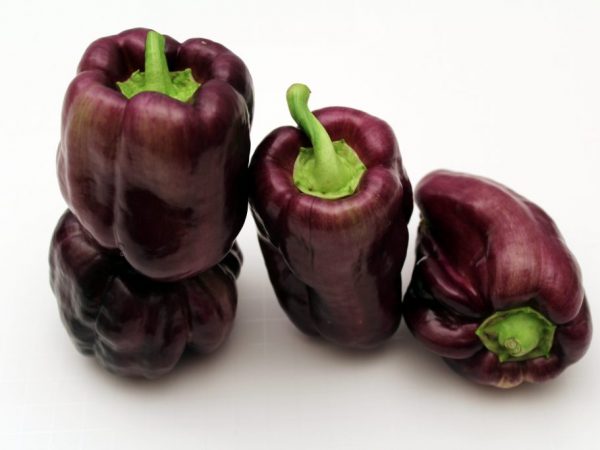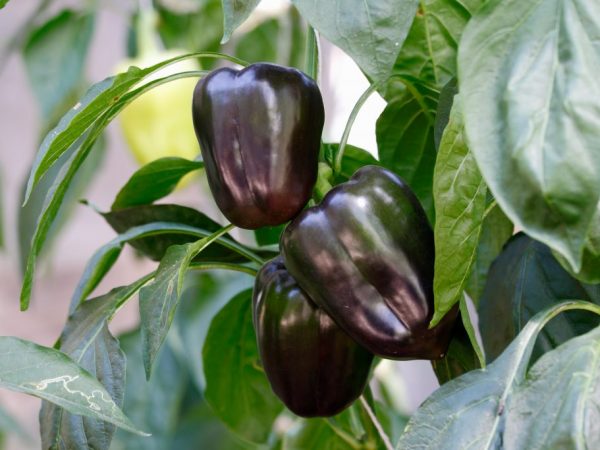Big papa sweet pepper
Pepper Big Papa stands out from all varieties with a unique color. It is excellent for growing in central Russia, due to its unpretentiousness and resistance to disease.

Big papa sweet pepper
Characteristics of the variety
Big daddy is a low-growing variety, it reaches a height of no more than 0.5 m. The foliage of the plant has a light purple tint. The inflorescences are blue at the flowering stage. The yield of a vegetable crop, subject to the rules of agricultural technology, is about 6.5-7.0 kg per 1 sq. m of landing area. Usually, more than 10 vegetables appear on 1 pepper bush.
Big papa pepper is great for fresh consumption and preserved.
Vegetables, according to the description, grow cone-shaped and at the stage of technical maturity have a characteristic purple color, by the time of biological maturation they become bright dark cherry. For fruits weighing about 90-120 g, the wall thickness is 5-7 mm.
Suitable climate
The most suitable conditions for growing the Big Papa variety is the middle strip, starting from the eastern part and passing through the entire East European Plain. The Volga region is also suitable for this vegetable crop.
When growing peppers in the northern regions, where the temperature in summer does not rise above 15-20 ° C, when cultivating a vegetable crop, shelter is required to create additional heat.
Best of all, Big Dad grows in the Volga region, especially in chernozem soil. Under these conditions, additional cover for the pepper is not required.
In areas with hot climates, it is required to protect the pepper bushes from leaf burns. In such conditions, it is required to install shading or plant peppers in places where there is no direct sunlight. In the southern regions, where it gets dark early and the duration of daylight hours is reduced, sometimes it is necessary to resort to additional lighting so that the daylight hours are at least 12 hours.
Soil requirements
In the middle lane, which has predominantly clay soil, when growing the Big Papa variety, they resort to mineral fertilizing. During wet rainy periods, when the clay soil is spreading, it is strengthened by adding sand.
Sandy soil for nutritional value is diluted with black soil or deciduous humus. The optimal ratio of all parts of the soil: clay, sand and fertilizers - in equal proportions.
Planting and leaving

Proper care will pay off
It is believed that the optimal time to plant Big Papa seeds is from late January to late February. Initially, seeds are recommended to be planted for seedlings at home, maintaining a temperature of 26-28 ° C, immersing the seed material to a depth of 3-4 cm. The germination rate of seeds purchased from a reliable manufacturer is high and reaches 80-90%.
Transfer
The grown seedlings are replanted 70-75 days after seed germination. The Big Papa seedlings prone to stress are treated with Epin during transplantation.
For 1 sq.m of sown area, no more than 5-6 seedlings are planted.
The average ripening period of the Big Papa pepper variety is 95-105 days from the moment of planting. Usually this time falls in May.
Care
When caring for Big Dad peppers, it is important to follow the basic principles of watering, fertilization and temperature conditions.
It is recommended to apply fertilizers at intervals of 1.5-2 weeks, which makes it possible to grow large vegetables. When feeding, it is worth adhering to the recommended standards so that overfed peppers do not become watery and do not lose their taste.
Advantages and disadvantages
The sweet Big Papa variety is a profitable vegetable crop that is suitable for large-scale farming and for growing in a backyard environment. Among the positive characteristics of pepper are:
- its resistance to low temperatures,
- high yields,
- the ability to adapt to local conditions,
- unpretentious care, no need for a garter,
- early ripening.
Among the negative characteristics of pepper are:
- susceptibility to stressful situations when growing conditions change;
- the ability to stop growth and development after transplantation;
- medium-sized fruits.
Conclusion
To increase the yield of a variety on the site, all its characteristics should be studied: this approach will minimize all risks, and the crop will grow healthy.


